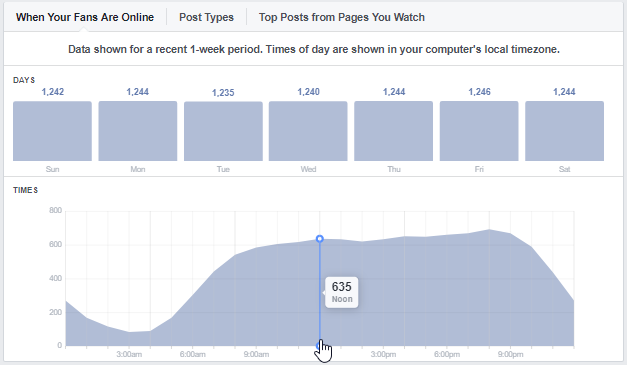“Timing is everything.”
“It’s all in the timing.”
“There is a time for everything.”
Studying Up
As mentioned, the question “when should I post on Facebook?” isn’t a new one. It’s been studied, analyzed, and written about many times. While each study contains slightly different insights, we’ve found there is a lot of overlap among them. Below we identify some of the leading studies on the matter, as well as some top-level insights.
Hootsuite, the social media marketing and management platform, recently released its report on the best times to post to social media sites . According to Hootsuite:
- The best time to post is between 12pm - 3pm on Monday, Wednesday, Thursday, and Friday. Tuesdays lag, but if you are posting on Tuesday, 12pm – 3pm is the recommended time.
- Weekends come with a narrower window of 12pm - 1pm.
Hubspot, the popular automation platform, compiled data from multiple sources and found:
- On average, 1pm-4pm is the best window for the highest click through rates.
- There is a reiteration that the 12pm - 1pm timeslot on weekends is ideal, but that posting before 8am and after 8pm is not recommended.
- Wednesday at 3pm was singled out as a particularly peak time.
Kissmetrics, the analytics and engagement platform, has a bit more to add.
- It agreed with previous studies that 12pm on Saturdays was the best time to post, also adding that there’s another spike in engagement on Saturdays at 7pm.
- There is a bit of a wider timing window noted here with 11am - to 4pm as the prime time to post. Here, lunchtime gets the credit for encouraging our minds to deviate from work to social media.
Buddy Media, a subsidiary of Salesforce, put together a SlideShare with additional recommendations:
- It encourages marketers to think outside normal business hours for posting as an opportunity to see up to 20% more engagement.
- We’re told Thursday and Friday may be the best days to post and show more engagement. Why? According to the presentation, “the less people want to be at work, the more they are on Facebook!”
- There’s also a very important component here that indicates the “best” time to post varies by industry. For example, retailer’s posts may be better used when customers are less “busy” between 8pm - 7am. Similarly, media companies should avoid Mondays, while financial companies and the automotive industry should really take advantage of Sundays.
Coschedule, the marketing calendar platform, compiled research from 20 different sources and highlighted each source’s recommendations. It generally target=_"blank">offers agreement that late-week and weekend posts at midday are the peak time for engagement.
Another general note to keep in mind is that nearly half of the US population lives in the Eastern Standard time zone and 75% live in Eastern or Central. So, if you’re on the West coast looking to increase your East coast audience, think about using these timing recommendations on their schedule.
What does all this really tell us? Largely that while many studies support one another’s findings, there are outliers and indications that sometimes it’s worth it to diverge from the beaten path. In general, there is not much advocacy here for posting at 10am on Tuesday and most agree that weekends shouldn’t be neglected. But beyond that, a case can be made that there is no universal answer for everyone.
There are also other factors like the frequency of posting and the type of content you post that can also affect performance. With so many variables at play there’s really only one thing left to do – your own research.
Using Your Own Data
Your existing Facebook account will provide plenty of insight to evaluate and test the behaviors of your audience.
When Is Your Audience Online?
Start by taking a good look at when most of your followers are online by going into your Facebook Insights and looking at Posts > When Your Fans Are Online. These hour and number correlations will be adjusted to the time zone of your computer.
While there may not be large differences in the size of the audience from hour-to-hour, you will likely be able to discern when the highest number of fans are active by day.
Audit Your Own Post Performance
Go back through your content and evaluate what you’ve posted, when, and the results. By evaluating how the work you’ve already done has performed, you may already be able to identify a pattern or correlation.
Your initial review will give you some ideas and starting points for a conscientious test. Make sure you create classifications for types of content like questions, company news, industry news, images, videos, etc. This will help you do a better job of comparing “apples to apples” when it comes to timing.
From there, outline what you want to test. Your process may include recreating what you found from your audit and research, or it may be trying to test some of the recommendations outlined above. Document exactly what you’re testing and what you’re looking to see. For example, you may want to find out on which days video posts can get more engagement by posting videos at the same time on different days over the course of several weeks.
It may take some time to get the full range of data you need but the insights you get will likely be well worth the wait.
Conclusion
It turns out there may be no “best” time to post on Facebook that is true for everyone. That may be a good thing, though. If there was one best time, all businesses would use it, potentially turning it into a “worst” time to post. However, by accounting for user behaviors, schedules, lifestyles and your own industry, you can target your content more effectively. Take these recommendations, your own data, and create a structured test to find the best posting schedule for your business.


